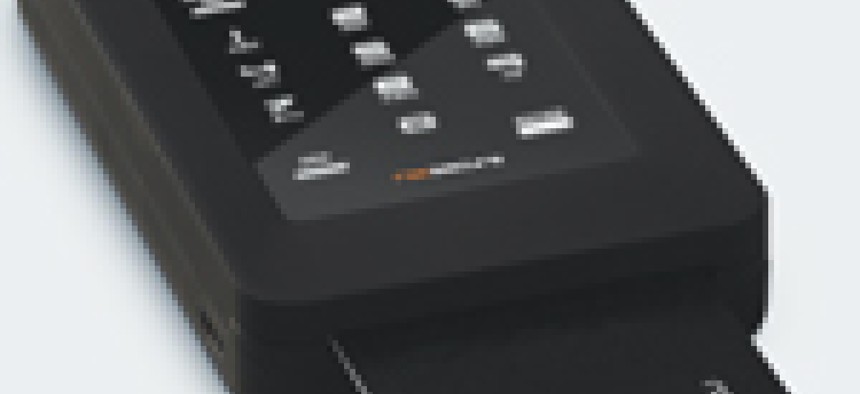Rocsafe drive weds portability and security


Connecting state and local government leaders
The Rocsafe MX Rocstor is a FIPS-certified, 500G portable hard drive with two-factor authentication.
Portability and security don’t often go hand in hand. All too often, one must be compromised for the sake of the other. Although more common lately, it’s still a rare thing to see the two concepts working smoothly together as well as they do with the Rocsafe MX portable hard drive from Rocstor.
The Rocsafe MX, which is a part of Rocstor’s Rocsecure line, consists of a 500G, 2.5-inch Serial Advanced Technology Attachment (Serial ATA) hard drive connected to a circuit board, enclosed in protective casing. The whole thing weighs 8.2 ounces and measures 5.1 inches by 3 inches by 0.9 inches. It easily fits into any of the pockets of our lab coats.
Because the manufacturers did not cite any Mil-Std 810F compliance for ruggedness, we did not perform drop tests or other rugged testing. However, we found the casing to be rather durable and, in our opinion, should be able to withstand moderate amounts of rough handling.
Rocsafe MX
We were pleased to see that you could power the Rocsafe MX by connecting it to two USB 2.0 ports — and it comes with a special twin-plug cable — or with a FireWire 400 or 800 port connection. If your computer provides power unreliably through those ports, there is also, available separately, a DC power adapter for use with the device.
Rocsafe MX complies with the Federal Information Processing Standards 140-2 Level 3 specification by providing two-factor authentication. We have not found this very often on portable drives, so we were pleased to see it used for the Rocsafe MX. First, a smart card that is ISO7816-compliant is inserted in the slot at the bottom. Then a password is entered on the touchpad keys on top of the drive.
Passwords can be any eight-digit string of numbers. But because the RocSafe only has number keys on its touchpad, the password must be numeric. And a user would need to be careful about substituting letters for numbers for mnemonic purposes because the letters printed under each number do not match the rather universally used pattern on telephone keys. And because the password is not truly alphanumeric, the Rocsafe MX is limited to 100 million combinations, which, although sufficient for most uses, is far less than the more than 200 billion different passwords a similarly lengthy string of numbers and letters affords.
Once authentication is complete, the Rocsafe MX shows up as a removable drive on the computer’s operating system. At this point, files on the drive are accessible, and you can copy files to the drive. When you are done, you just disconnect the Rocsafe MX as you would any other portable drive.
We found the touchpad to be a little difficult to use, as we had trouble entering some of the numbers on the first try. However, the size of the Rocsafe MX makes it easy to hold in one hand as the smart-card insertion and password entry is performed with the other, which should help keep incorrectly entered numbers to a minimum.
Although the pad lights up quite brightly when the Rocsafe MX is first powered up, it dims a bit too much afterward, making reading the status and error lights difficult. We got around this by shading the display with a hand, but a user might not always have this luxury. Without a display to tell you that a key has been pressed, the Rocsafe MX relies upon making clicking sounds, which serves the purpose quite nicely. The click is sounded twice when a correct password is entered.
Many things set the Rocsafe MX apart from other secure, portable storage options. One is that the 256-bit Advanced Encryption Standard encryption is done on the hardware level, which is more secure than software-based encryption.
And although most drives focus on data security through encryption, sometimes defenses against physical hacking are lax. Not so with the Rocsafe MX. The circuit board has a special epoxy that will cause the board to break if it is tampered with. And of course, because it is at heart a regular Serial ATA hard drive, the Rocsafe MX can be used with Windows or Mac systems.
To test the drive performance via a USB 2.0 connection, we timed how long it took to copy a folder with approximately 2G of various files. We did the file transfer several times in both directions and averaged the results. In this environment, the Rocsafe MX achieved a data transfer rate of 95.4 megabits/sec when copying to the drive and 193.3 megabits/sec when moving files from the drive to the computer. Those are pretty good rates for an encrypted drive, especially considering the chokepoint that USB can be on a busy computer.
Rocstor is selling the Rocsafe MX for $795. Although that is greater than the cost of a regular hard drive by about a factor of eight, the functioning two-factor authentication makes this a worthwhile price. The government price drops to an impressive $350 — quite a bargain.
With the Rocstor MX, at last, portability and security can be thought of as allies instead of rivals.
Rocstor, www.rocstor.com
NEXT STORY: Zero-day Windows kernel flaw linked to Clipboard




